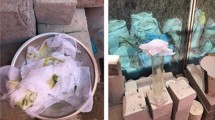Abstract
With the development of trackless equipment and filling technology, the high stage subsequent cemented filling method had been successfully applied in Lilou mine. On account of price of collapsed severely of iron ore, it was of paramount importance to defuse costs on the basis of ensuring the strength of the filling body. Based on the slump test of whole tailing slurry, 9 groups of ratio tests were devised and the strength prediction model of cemented backfill was established. The actual cement consumption in the stope was calculated by using the fitting formula of the prediction model. The quantitative relationship between the design and actual cement consumption was analyzed. The results showed that there was a large surplus of cement dosage in the 12-1#and 12-5# stope, which were 19.45 and 17.56% respectively more than design. Along with improvement of technical proficiency and calibration of measuring instruments and materials conveying equipment, the cement consumption will be reduced in a larger space.









Similar content being viewed by others
References
Amaratunga LM, Yaschyshyn DN (1997) Development of a high modulus paste filusing fine gold mill tailings. Geotech Geol Eng 15(3):205–219
Cao S, Du CF, Tan YY, Fu JX (2015) Mechanical model analysis of consolidated filling pillar using stage-delayed backfill in metal mines. Rock Soil Mech (China) 8:2371–2376
Chen YG, Ye WM, Zhang KN (2009) Strength of copolymer grouting material based on orthogonal experiment. J Central South Univ Technol 16:143–148
Edwards F (1992) Backfilling in underground mines. In: AIME annual general meeting, Canada
Fall M, Celestin JC, Pokharel M (2010) A contribution to understanding the effects of curing temperature on themechanical properties of mine cemented tailings backfill. Eng Geol 10:397–413
Fu JX, Du CF, Song WD (2014) Strength sensitivity and failure mechanism of full tailings cemented backfills. J Univ Sci Technol Beijing 9:1149–1157
Guo LJ, Yang XC (2008) Test on cemented rock-tailings filling. J Wuhan Univ Technol 30(11):75–78
Hussain NA, Fall M (2011) Unsaturated hydraulic properties of cemented tailings backfill that contains sodium silicate[J]. Eng Geol 123(4):288–301
Lin L (2011) Quantifying TiO2 abundance of lunar soils: partial least squares and stepwise multiple regression analysis for determining causal effect. J Earth Sci 22(5):549–565
Ren HG, Tan ZY, Cai XF (2010) AHP-fuzzy optimization of structural parameters in sublevel open stope succedent filling method. J Univ Sci Technol Beijing 23:1383–1387
Ren HF, Song WD, Ding ML (2014) Orthogonal analysis of the strength influence factors of the backfilling consolidated filling body. Mod Ming (China) 12:152–155
Shu GL, Xun LJ, Ling TH (2003) Cementing filling materials proportioning cost optimization for NO.1 orebody at chagan silver deposit. Metal Mine (China) 1:4–7
Wang XM, Xu DS (2006) Research on optimization proportioning of cemented filling material and strength forcasting. Expr Inf Min Ind 12:20–23
Xiang YB (2003) Linear regression statistics of analytical data. Metall Anal (China) 23(6):62–65
Yilmaz E, Benzaazoua M, Belem T, Bussière B (2009) Effect of curing under pressure on compressive strength development of cemented paste backfill. Miner Eng 22:772–785
Acknowledgements
Funding was provided by the national science and technology support program (Grant No. 2013BAB02B08)
Author information
Authors and Affiliations
Corresponding author
Rights and permissions
About this article
Cite this article
Wei, X., Li, C., Zhang, L. et al. Strength Prediction Model of Cemented Backfill and Inversion Calculation of Cement Consumption. Geotech Geol Eng 36, 649–656 (2018). https://doi.org/10.1007/s10706-017-0318-5
Received:
Accepted:
Published:
Issue Date:
DOI: https://doi.org/10.1007/s10706-017-0318-5




